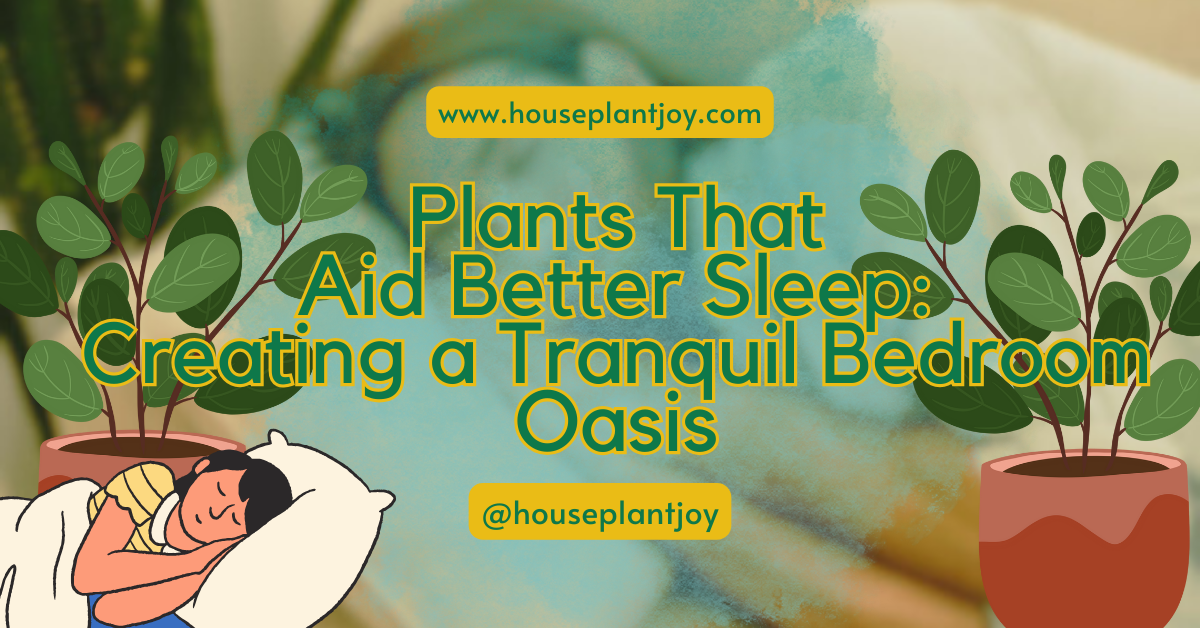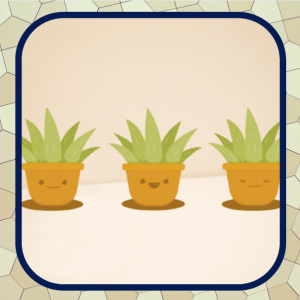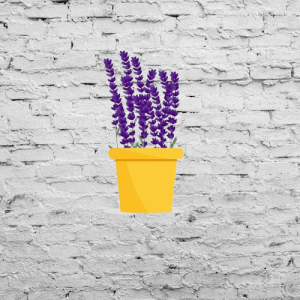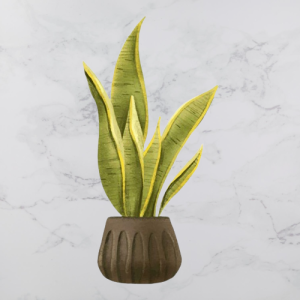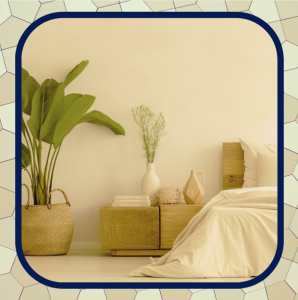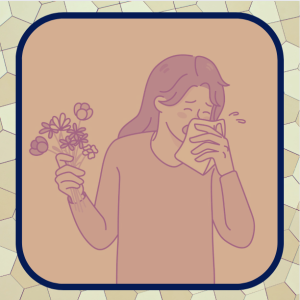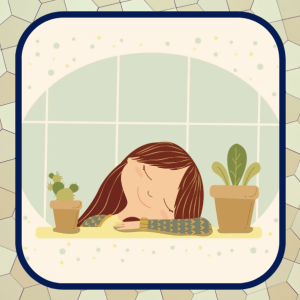HousePlantJoy is supported by our audience. When you purchase through one of our links, we may earn a small affiliate commission. As an Amazon Associate I earn from qualifying purchases. Your cost is not affected.
==================
Transforming your bedroom into a sleep sanctuary doesn’t have to be complex or costly. Introducing plants that aid better sleep is a natural and aesthetically pleasing way to enhance the quality of your bedtime slumber.
Plants That Aid Better Sleep: The Ultimate Guide to a Tranquil Bedroom Oasis
Plants are not just decorative. Certain species can purify the air, emit soothing scents, and produce oxygen. All of which contribute to a more restful night.
Sleep is a vital component of overall health, and creating an environment that supports it can profoundly impact your physical and mental well-being.
The connection between botany and a good night’s rest is rooted in science and tradition. Incorporating greenery into your resting space taps into the calming benefits of nature, which may include reduced stress levels and improved air quality.
Selecting the ideal plants for your bedroom requires consideration of their oxygen production, air-purifying abilities, and the sensory experience they provide. There are even options for those prone to allergies, ensuring everyone can breathe easier and embrace a tranquil atmosphere for sleep.
Key Takeaways
- Houseplants can enhance sleep quality through air purification and oxygen production.
- Choosing the right plants for the bedroom involves balancing aesthetics with health benefits.
- Allergen-friendly plant options are available to ensure restful sleep for everyone.
The Science of Sleep and Botany
To optimize your sleep quality, it’s essential to understand your natural sleep cycles and how plants can contribute to a more restful night. The strategic use of certain plants that aid better sleep in your bedroom can enhance the environment for relaxation and sleep.
Understanding Sleep Cycles
Your body progresses through various stages of sleep, cycling through light to deep sleep multiple times per night. This rhythm is governed by your circadian clock, which is influenced by environmental cues.
Role of Plants in Sleep Improvement
Plants can improve sleep quality by purifying the air and releasing calming scents. For instance, studies show that the fragrance of lavender can help calm nerves and is linked to improved sleep. Plants like gardenia and jasmine are also known for their soothing aromas, which may contribute to a more tranquil environment conducive to rest.
Top Plants for a Sleep-Inducing Bedroom
Transforming your sleeping space into a tranquil oasis can be as simple as introducing suitable greenery. Certain plants are celebrated for their soothing qualities and aid your ability to sleep properly.
Lavender
Lavender, a plant famed for its calming scent, can improve your slumber. Research supports lavender’s ability to alleviate anxiety, potentially leading to deeper, more satisfying sleep.
Jasmine
30 Bedroom Plants to Help With Better Sleep – The presence of Jasmine’s delicate white flowers emits a sweet fragrance, contributing to reduced sleep movement and heightened sleep quality.
Aloe Vera
Not only is Aloe Vera a low-maintenance plant, but it’s also an excellent air purifier. Its capability to produce oxygen at night can enhance your bedroom environment for better sleep.
Snake Plant
Consider incorporating a Snake Plant into your bedroom for its remarkable air-purifying properties. It’s known for filtering indoor air toxins and releasing oxygen, promoting an atmosphere conducive to sleep.
Gardenia
The 9 Best Plants to Help You Sleep at Night – Gardenia, with its lush, aromatic blossoms, has a soothing effect similar to certain sleep medications, making it a natural option for improved sleep quality.
Creating Your Bedroom Oasis
In crafting a tranquil bedroom retreat, smart plant choices and their thoughtful placement are critical. Please care for your plants to ensure they continue to enhance your space and leverage the calming scent of certain species for a holistic approach.
Plant Placement and Bedroom Layout
Strategically arranging your plants can optimize their air-purifying and aesthetic benefits. Positioning a ZZ Plant or Snake Plant near your bed can enhance air quality while you sleep.
Please ensure each plant has enough space to grow and consider the light requirements. Peace lilies thrive in indirect light, while a Snake Plant can withstand lower light conditions.
Caring for Your Sleep-Friendly Plants
Maintaining your plants is essential for their longevity and your sleep quality. Simple routine care like watering and dusting the leaves and occasional fertilization will keep plants like the Lavender and Parlor Palm healthy. Be mindful of overwatering, as soggy soil can lead to root rot, damaging your plants.
Combining Aromatherapy and Plant Benefits
Enhance the sleep-inducing atmosphere by incorporating plants with natural aromas. Lavender is famous for its relaxing scent, which can reduce stress and improve sleep quality. In addition to their visual appeal, these aromatic plants serve a dual purpose, elevating your bedroom to a restful haven.
Considerations for Allergy Sufferers
When selecting bedroom plants that aid better sleep, it’s crucial to choose wisely if you have allergies. Some plants may aggravate allergies, while others can be beneficial.
Here are vital steps to create an allergy-friendly bedroom oasis:
- Select Hypoallergenic Plants: Opt for plants like the Areca Palm, which, according to studies, is an excellent air purifier and a natural humidifier, helping to alleviate symptoms like nasal congestion.
- Reduce Humidity: Avoid overwatering plants in the bedroom, as too much humidity can encourage mold growth, which may trigger allergies.
- Keep It Clean: Regularly clean the leaves of indoor plants to prevent dust accumulation.
- Beware of Pollen: Choosing plants that don’t produce a lot of pollen is essential. Plants such as ferns are typically a safe bet.
Helpful Plants List:
| Plant Name | Benefits | Maintenance Tips |
|---|---|---|
| Areca Palm | Air purifying, humidifying | Wipe leaves, avoid overwatering |
| Spider Plant | Air purifying, safe for pets | Easy to care for, bright light |
| Snake Plant | Improves air quality | Low water, low light tolerant |
Consider personal sensitivity levels and consult an allergist with concerns about specific plants. Creating a restful bedroom space entails a balance of aesthetics, air quality, and allergen management. Choose plants that contribute to clean air and restorative sleep without worsening your allergy symptoms.
Enhancing Sleep Quality Beyond Plants
While plants can contribute to a restful bedroom environment, there are additional factors you can modify to improve sleep quality further. Paying attention to these plants that aid better sleep will help transform your bedroom into an ideal sleep sanctuary.
Reducing Noise and Light Pollution
To diminish noise pollution, consider using earplugs or a white noise machine to mask unwanted sounds. Creating a barrier against external noises that could disrupt your sleep is essential.
For light pollution, blackout curtains are highly effective. They block intrusive light from outside and help insulate your room, contributing to a more controlled sleeping environment.
Temperature and Bedding Impact
The ideal bedroom temperature for sleep is around 65 degrees Fahrenheit (18.3 degrees Celsius). Use a thermostat or open windows to regulate the room to this temperature for optimal sleep conditions. When it comes to bedding, opt for breathable materials like cotton or linen, which assist in maintaining a comfortable body temperature throughout the night.
Video Credit: @BalconyGardenWeb
Wrapping It Up
Certain plants can help you sleep better. Choose ones like lavender or aloe vera for a tranquil bedroom. They not only look good but also improve air quality.
Place them where they can get light but not disturb your sleep. Caring for them becomes a relaxing routine. Enjoy a more peaceful sleep surrounded by these calming greens!
Frequently Asked Questions
What are the top plants known to enhance sleep quality?
Some of the most effective plants that aid better sleep include the Snake Plant and Lavender, both renowned for their air-purifying and calming properties.
Can keeping certain plants in the bedroom improve air quality for better sleep?
Yes, plants like the Snake Plant are known to filter indoor air, potentially improving its quality and supporting better sleep.
Are any plants recommended for ease of care in a bedroom environment?
The ZZ Plant is particularly low-maintenance and can thrive in a bedroom setting, making it a practical choice for enhancing sleep without requiring extensive care.
Which plants are specifically beneficial for placing on a bedroom windowsill?
English Ivy is ideal for a windowsill, thanks to its ability to cascade elegantly and its beneficial oxygen-releasing qualities.
Does the presence of plants like lavender in the bedroom aid in better sleep?
Lavender is known for its soothing fragrance, which can lower stress and heart rate, creating a more conducive sleep environment.
Are there any plants shown to positively affect conditions like sleep apnea?
While plants cannot treat sleep apnea, the increased air quality from plants like the Snake Plant may contribute to a minor improvement in breathing for some individuals during sleep.
Learn More About Houseplants!
Discover more types of houseplants, their benefits, and how to care for them with us! Join us on Facebook, Instagram, and Twitter for beautiful photos, plant care tips, and a community that celebrates the joy of indoor gardening.
Facebook: https://www.facebook.com/houseplantjoyblog
Instagram: http://instagram.com/houseplantjoy20
Twitter: https://twitter.com/HouseplantJoy
Let’s nurture our green spaces together!

